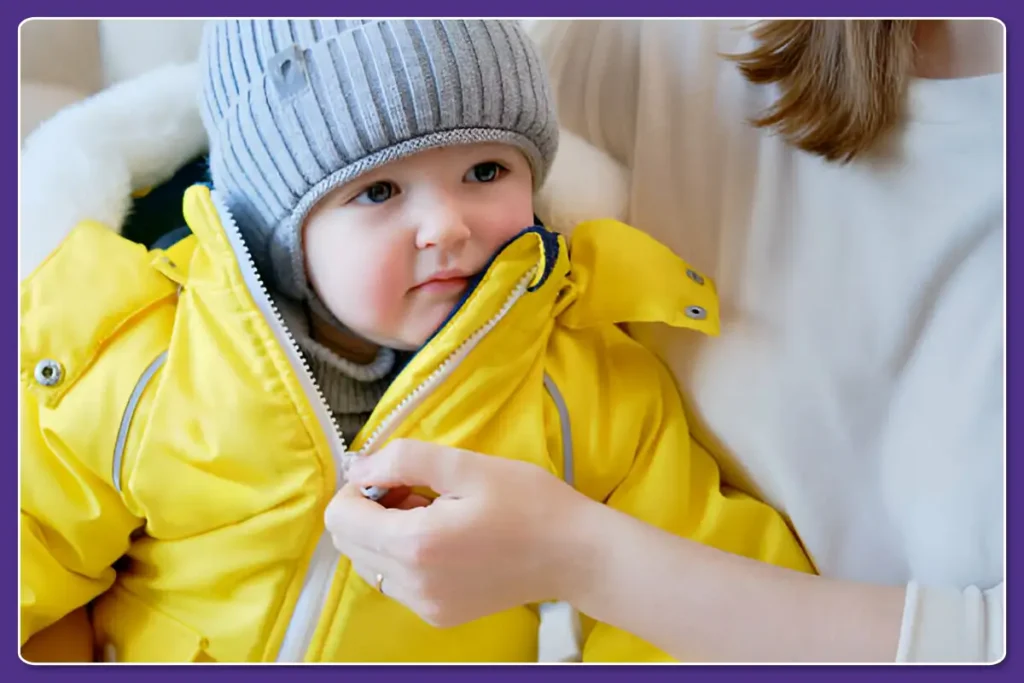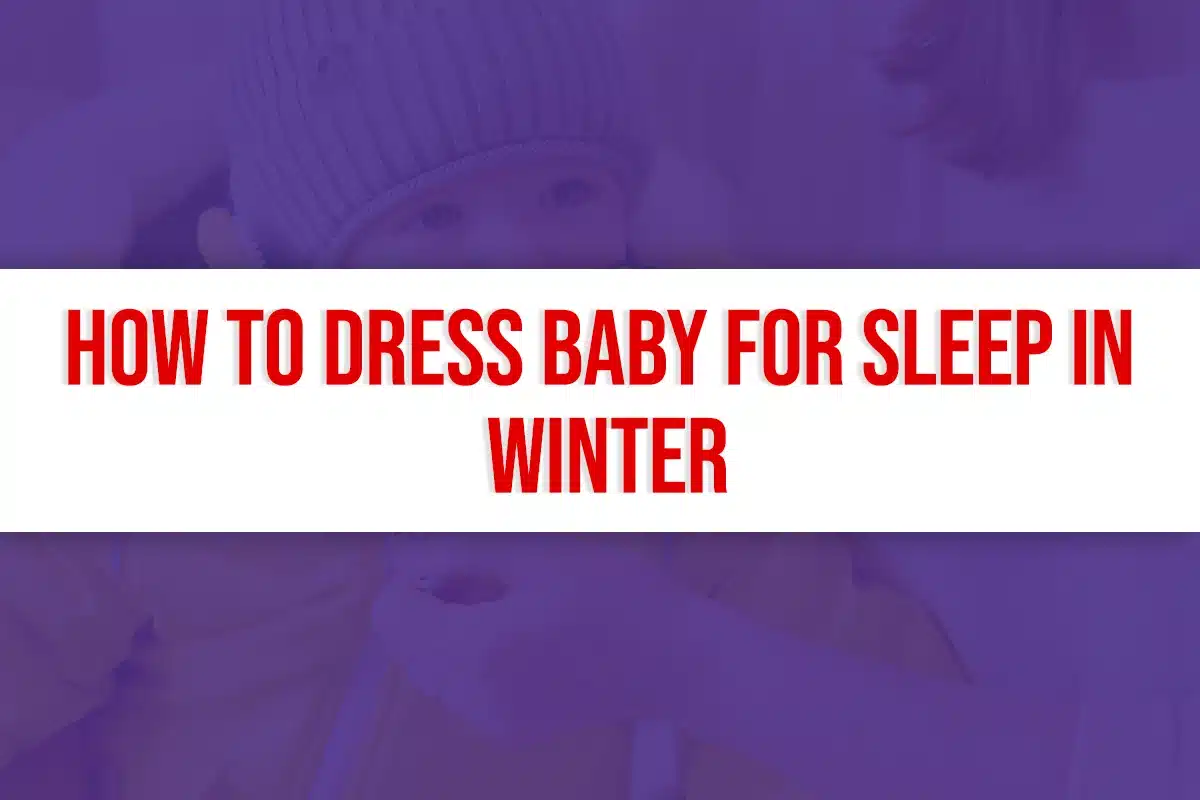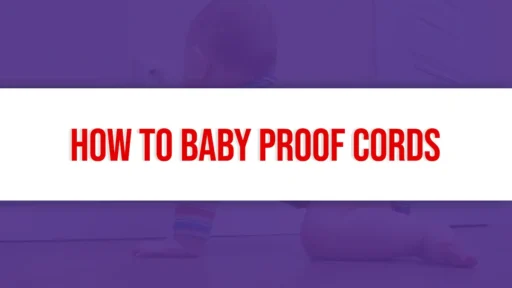Dressing a baby for sleep in winter can be tricky. Babies need to stay warm, but not too warm.
Winter nights are cold, and your baby’s comfort is crucial. You want to ensure they sleep well, but you must also keep them safe. Overheating or being too cold can disturb their sleep. So how do you dress your baby properly?
Understanding the right clothing layers and materials can help. This blog will guide you on how to dress your baby for a cozy and safe winter sleep. We’ll cover the best practices to keep your baby comfortable all night. Read on to discover the secrets to a peaceful winter sleep for your little one.

Choosing The Right Fabric
Choosing the right fabric for your baby’s sleepwear is crucial in winter. The fabric not only provides warmth but also ensures comfort and safety. Let’s explore the best options for your little one’s peaceful sleep.
Natural Fibers
Natural fibers are the best choice for your baby’s sleepwear. Cotton, wool, and bamboo are great options. These materials are soft on the skin and free from harmful chemicals. Cotton is particularly popular for its softness and breathability. It keeps your baby warm without causing overheating.
Wool is another excellent choice. It has natural insulating properties and can regulate body temperature. This helps in keeping your baby warm during cold nights. Bamboo fabric is also gaining popularity. It is soft, hypoallergenic, and has moisture-wicking properties. This keeps your baby dry and comfortable.
Breathable Materials
Breathable materials are essential for your baby’s comfort and safety. Fabrics like cotton and bamboo allow air circulation. This prevents overheating and ensures a comfortable sleep environment. Breathable materials also reduce the risk of skin irritation and rashes.
Look for sleepwear that has a loose fit. This allows for better air circulation. Avoid synthetic fabrics like polyester. These can trap heat and moisture, causing discomfort. Always choose sleepwear that combines warmth with breathability. This ensures your baby stays cozy and comfortable throughout the night.
Layering Techniques
Dressing your baby for sleep in winter requires careful layering. Proper layering keeps your baby warm and comfortable. Let’s explore the essential layers.
Base Layer
The base layer is the first layer of clothing. Choose a soft, breathable fabric like cotton. This layer should fit snugly but not too tight. It helps in maintaining body temperature and wicking away moisture.
Middle Layer
The middle layer provides insulation. Opt for a fleece or a lightweight wool material. This layer traps body heat, keeping your baby warm. Ensure it’s not bulky, allowing easy movement.
Outer Layer
The outer layer protects against cold air. Use a sleep sack or a wearable blanket. This layer should be windproof and water-resistant. It adds an extra barrier without overheating your baby.
Selecting The Right Sleepwear
Winter nights can be chilly, and ensuring your baby is warm and comfortable during sleep is crucial. Selecting the right sleepwear is key to keeping your little one cozy and safe. Let’s explore the best options for baby sleepwear during the cold winter months.
Onesies And Pajamas
Onesies and pajamas are great for winter nights. They provide full-body coverage and keep your baby warm. Choose onesies made of soft, breathable fabrics. Cotton is a good choice because it is gentle on the skin. Avoid synthetic materials that might cause irritation.
Ensure the onesies have a snug fit. Loose clothing can ride up and expose your baby’s skin to the cold. Look for onesies with built-in footies. These keep your baby’s feet warm without the need for extra socks.
Sleep Sacks
Sleep sacks are an excellent option for winter sleepwear. They resemble wearable blankets and provide a safe alternative to loose blankets. Sleep sacks keep your baby warm without the risk of suffocation. Choose sleep sacks made from materials like fleece or cotton.
Ensure the sleep sack fits well around your baby’s neck and arms. A good fit prevents your baby from slipping inside. Sleep sacks come in various thicknesses. Pick one suitable for your home’s temperature. Thicker sleep sacks are ideal for colder rooms.
Using sleep sacks and onesies together can offer extra warmth. Layering these items ensures your baby stays cozy throughout the night.
Managing Room Temperature
Managing room temperature is key to ensuring your baby sleeps well in winter. The right temperature can help your baby stay comfortable and safe. Let’s discuss the ideal temperature range and the benefits of using humidifiers.
Ideal Temperature Range
Keeping your baby’s room at the right temperature is crucial. The ideal temperature range for a baby’s sleep is between 68°F and 72°F (20°C to 22°C). This range keeps your baby warm enough without overheating.
You can use a room thermometer to monitor the temperature. Make sure to keep the crib away from windows and direct drafts. If the room gets too cold, consider using a space heater with a thermostat. Always ensure it’s safe and out of your baby’s reach.
Using Humidifiers
Winter air can be dry, which may cause discomfort for your baby. Using a humidifier adds moisture to the air, which can help prevent dry skin and nasal congestion. This can improve your baby’s comfort and sleep quality.
There are different types of humidifiers, such as cool mist and warm mist. Cool mist humidifiers are generally safer for baby rooms. Place the humidifier at a safe distance from the crib and clean it regularly to prevent mold and bacteria buildup.
Here’s a simple table to compare the pros and cons of cool mist and warm mist humidifiers:
| Type | Pros | Cons |
|---|---|---|
| Cool Mist | Safer for babiesCost-effective | May need regular filter changes |
| Warm Mist | Effective for cold symptoms | Risk of burnsHigher energy use |
By managing the room temperature and using a humidifier, you can create a cozy environment for your baby. This ensures they sleep comfortably through the cold winter nights.
Keeping Baby’s Head Warm
During winter, keeping your baby’s head warm is essential. The head loses heat faster than other body parts. Ensuring your baby’s head stays warm can help them sleep better and stay healthy. Let’s explore some practical tips to achieve this.
Hats And Caps
Hats and caps are a simple way to keep your baby’s head warm. Choose hats made from soft, breathable fabrics. Cotton or wool blends are excellent choices. Ensure the hat fits snugly but not too tight. This helps maintain warmth without causing discomfort.
Avoiding Overheating
While keeping your baby’s head warm is crucial, avoid overheating. Overheating can be harmful. Use lightweight hats indoors. Monitor your baby for signs of discomfort. If your baby seems too warm, remove the hat. Keeping a balance is key.
Ensuring Safe Sleep
Ensuring your baby’s safe sleep in winter is critical. Dressing them correctly can help. Let’s explore some important tips to keep your baby safe and warm during winter nights.
Avoid Loose Blankets
Loose blankets can be a safety hazard. They pose a risk of suffocation. Instead, use a sleep sack or wearable blanket. These keep your baby warm without the risk of covering their face.
You can also consider layering. Dress your baby in snug, warm layers. Think of footed pajamas or a sleep sack. This way, your baby stays warm without loose items in the crib.
Safe Sleep Position
The safest sleep position for a baby is on their back. This reduces the risk of sudden infant death syndrome (SIDS). Ensure your baby sleeps on a firm mattress with a fitted sheet.
Avoid placing pillows, toys, or bumper pads in the crib. These items can obstruct your baby’s breathing. Keep the crib free from unnecessary items.
Remember, your baby’s comfort and safety are most important. Dress them in appropriate layers. Follow safe sleep guidelines to ensure a restful night for both you and your baby.
Monitoring Comfort
Monitoring your baby’s comfort during winter sleep is crucial. Babies can’t tell us if they are too hot or cold. Parents must observe and adjust their baby’s sleepwear and environment. This will ensure they sleep soundly and safely through the night.
Checking Baby’s Skin
Regularly check your baby’s skin to ensure they are comfortable. Touch their chest, back, or tummy. These areas give a good indication of their overall body temperature. Their skin should feel warm but not hot. Cool skin might mean they need an extra layer. Warm skin is a sign they are just right.
Signs Of Overheating
Overheating is dangerous for babies. Look for signs like sweating, flushed cheeks, or damp hair. Your baby might also be more irritable than usual. If you notice any of these signs, remove a layer of clothing. Ensure their room temperature is between 68-72°F (20-22°C). This helps maintain a safe and comfortable sleep environment.
Using Swaddles Effectively
Winter nights can be cold and uncomfortable for babies. Using swaddles effectively can ensure your baby sleeps warmly and securely. Swaddling mimics the snug feeling of the womb, promoting better sleep. It reduces the startle reflex and helps your baby stay asleep longer. This section will guide you on when to swaddle and the right swaddling techniques to keep your baby cozy during winter nights.
When To Swaddle
Swaddle your baby from birth to around two months. At this age, babies have a strong startle reflex. Swaddling helps reduce this reflex, leading to better sleep. Stop swaddling once your baby shows signs of rolling over. This usually happens around two to four months. Swaddling a rolling baby can be unsafe. Always monitor your baby’s development closely.
Swaddling Techniques
Choose a lightweight and breathable swaddle blanket. Place the blanket on a flat surface, forming a diamond shape. Fold the top corner down about six inches. Lay your baby on the blanket with their neck on the fold. Gently hold one arm down by their side. Pull the same side of the blanket across their body. Tuck it under their back. Repeat with the other arm and side of the blanket. Ensure the swaddle is snug but not too tight. The baby’s hips should have room to move. This helps prevent hip dysplasia.
Practice the swaddling technique until you feel confident. Always place the baby on their back to sleep. Use swaddles designed for safe sleep. Avoid overheating by dressing your baby in light sleepwear under the swaddle. Check your baby’s temperature often. Adjust the layers if needed.
Frequently Asked Questions
Choose soft, breathable fabrics like cotton or fleece. They keep your baby warm without overheating. Avoid synthetic materials.
Dress your baby in one more layer than you would wear. This helps keep them warm and cozy.
Yes, sleep sacks are great for winter. They provide warmth without the risk of loose blankets.
Avoid loose blankets. They can pose a suffocation risk. Use sleep sacks or wearable blankets instead.
Conclusion
Ensuring your baby stays warm at night is crucial during winter. Layering is key. Always choose breathable fabrics to prevent overheating. A snug sleep sack can add extra warmth. Monitor your baby’s temperature regularly. Keep the room at a comfortable temperature.
These tips help ensure your baby sleeps safely and soundly. Rest easy knowing your little one is cozy and protected. Sleep well, and enjoy those winter nights!







